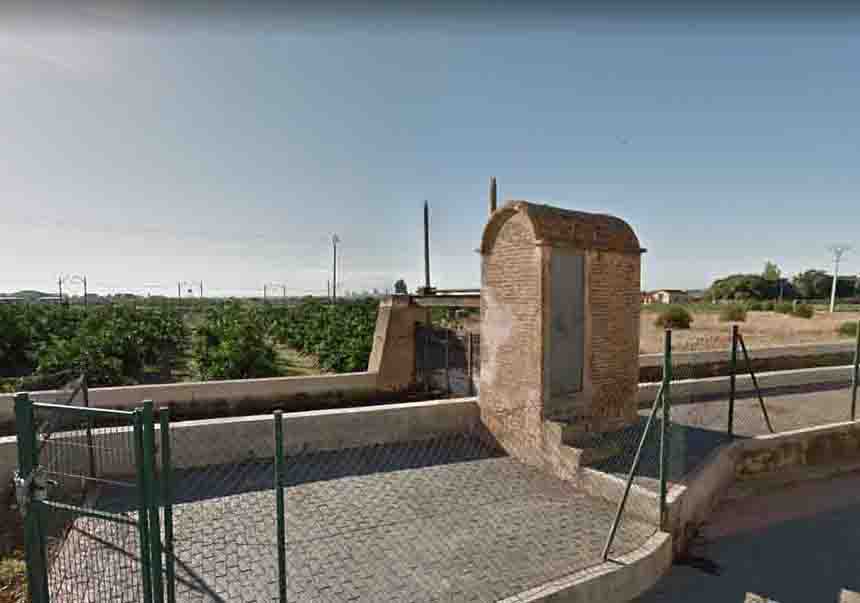
It is located on the Real Séquia de Moncada by the urban area of the same town, in the old district of the Francs, now largely urbanised, and some 200 metres before the canal reaches the mill of Moncada. You can get there from the town centre along the Real Sequiera street.
17th century
According to Guinot et al (1999), the “Cuadrado de Moncada” is a large sluice gate that was installed in the Real Acequia de Moncada in the 17th century to stop the entire flow of the ditch and raise the water level in order to irrigate the left side of the canal, the so-called "alters", through a mouth and ditch located at a higher level. It is possible that such a construction is older, but so far the first concrete evidence is that of the expert examination of 1658, an inspection-inventory of the route of the Real Acequia de Moncada, ordered by its Board of Directors. Considering its function as well as the fact that it cuts off all the irrigation water for two thirds of the territory of this irrigators community, it is clearly an extension of the original medieval and Islamic system. During the centuries of its operation it has always been a facility controlled and managed by the Board of Directors of the community. This is not the only sluice gate in the Moncada irrigation canal. However, from the hydraulic point of view, it is the most important and has the greatest impact on the organisation of irrigation. In the mid-19th century irrigators had the right to water on alternate Wednesdays and in the 20th century this right was changed to a weekly basis. The sunrise on Wednesdays marked the closing of the sluice gate, which retained all the flows of the irrigation canal until the water accumulated in its bed with enough height to supply the sluices on the left bank of the irrigation canal. It encompassed the districts of Moncada, Massarrojos, Rocafort and some of Godella, and thus irrigated the corresponding fields. This operation traditionally lasted until sunset on the same day.
According to Guinot et al (1999), it is located approximately at the height of the first third of the route of the canal since it begins to irrigate, in an environment that used to be entirely agricultural, but nowadays it is located to a new neighbourhood of the town of Moncada and the street surrounding it. Traditionally, this dam was made with large wooden rafters that were fitted by hand and with mallet and hammer blows into two guides embedded in stone and ashlar walls on either side of the canal. This operation was carried out by the guards. T.Peris explains that, according to an expert examination of 1658 included in the Ordinances of the Acequia, the dam of the sluice gate was made: “with stone branches; it is thirteen palms wide, and eight palms high. It is closed on the “día de cuadrado” (Wednesdays when the gate was closed) with beams and [planks]; and it is also closed from fifteen to fifteen days, there being no problems of dryness [drought], according to royal privileges”. At the same time, the "cuadrado" is a large wooden sluice gate, the control mechanisms of which are made of iron and are protected inside an annexed gatehouse in the form of a hut. The gate is now 2.80 m wide and 3.30 m high, a little less than the 13 palms of the 17th century.
GUINOT, E.; et al. (1999: La Real Acequia de Moncada, València: Generalitat Valenciana, Conselleria d’Agricultura, Peixca i Alimentació. Col·lecció Camins d’Aigua, p. 186 pp. ISBN 84-482-2341-1.
PERIS ALBENTOSA, T.: “Gestionar la irregularidad hídrica. Policultivo intensivo, flexibilidad operativa y adaptación organizativa en la Acequia de Montcada, (Huerta de Valencia) durante los siglos XIII-XIX”, Recs històrics: pagesia, història i patrimoni. IX Congrés sobre Sistemes Agraris, Organització social i Poder local, Lleida, Universitat de Lleida, 2016.
Photos: Càtedra L'Horta de València - Google Earth














